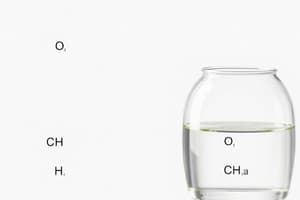Podcast
Questions and Answers
In a single displacement reaction, a more reactive element replaces a less reactive ______.
In a single displacement reaction, a more reactive element replaces a less reactive ______.
element
The reaction of an acid with a base results in the formation of ______ and water.
The reaction of an acid with a base results in the formation of ______ and water.
salt
When copper wire is dipped in silver nitrate solution, it gets coated with ______.
When copper wire is dipped in silver nitrate solution, it gets coated with ______.
silver
Aqueous sodium chloride and silver nitrate react to form a white precipitate of ______.
Aqueous sodium chloride and silver nitrate react to form a white precipitate of ______.
Iron is more reactive than ______, which leads to the displacement reaction.
Iron is more reactive than ______, which leads to the displacement reaction.
When a compound is formed from its elements, the reaction is called a ______ reaction.
When a compound is formed from its elements, the reaction is called a ______ reaction.
Decomposition reaction is one in which a compound ______ into two or more substances.
Decomposition reaction is one in which a compound ______ into two or more substances.
Magnesium reacts with oxygen on heating to form ______.
Magnesium reacts with oxygen on heating to form ______.
When calcium hydroxide is heated, it produces calcium oxide and ______.
When calcium hydroxide is heated, it produces calcium oxide and ______.
Decomposition is normally caused by ______ or by passing electricity through it.
Decomposition is normally caused by ______ or by passing electricity through it.
Flashcards are hidden until you start studying
Study Notes
Single Displacement Reaction
- Involves the replacement of one element in a compound by another more reactive element.
- Example: Iron displaces copper in copper sulfate, resulting in iron sulfate and copper deposit.
- Reaction formula: $CuSO_4 + Fe \longrightarrow FeSO_4 + Cu$
Double Displacement Reaction
- Characterized by the exchange of elements or groups between two compounds.
- General formula: $AB + CD \longrightarrow AD + CB$
Precipitation Reactions
- Occur when two aqueous compounds react to form an insoluble solid called a precipitate.
- Example: Sodium chloride reacts with silver nitrate, forming a white precipitate of silver chloride.
- Reaction formula: $NaCl + AgNO_3 \longrightarrow AgCl + NaNO_3$
Neutralisation Reactions
- An acid reacts with a base to produce salt and water.
- General formula: $HA + BOH \longrightarrow AB + H_2O$
- Example: Sulphuric acid reacts with sodium hydroxide to yield sodium sulfate and water.
- Reaction formula: $H_2SO_4 + 2NaOH \longrightarrow Na_2SO_4 + 2H_2O$
Activity: Displacement Reaction Between Copper and Iron
- Observational experiment involving copper sulfate and an iron nail.
- Iron nail submerged in copper sulfate solution changes color to green, indicating iron sulfate formation.
- A brown copper deposit forms on the iron nail.
Activity: Copper and Silver Nitrate
- When copper wire is immersed in silver nitrate solution, it gets a silver coating.
- Solution coloration shifts to bluish due to copper nitrate formation.
- Reaction formula: $2AgNO_3 + Cu \longrightarrow Cu(NO_3)_2 + 2Ag$
Types of Chemical Reactions
- Chemical reactions are categorized based on observable patterns, facilitating product prediction.
Combination Reaction
- Formation of a compound from two or more elements or simpler substances.
- General formula: $A + B \longrightarrow AB$
- Example: Magnesium and oxygen react to form magnesium oxide upon heating.
- Reaction formula: $2Mg + O_2 \longrightarrow 2MgO$
Decomposition Reaction
- Process where a compound breaks down into two or more simpler substances, often driven by heat or electricity.
- General formula: $AB \longrightarrow A + B$
- Example: Calcium hydroxide decomposes into calcium oxide and steam upon heating.
- Reaction formula: $Ca(OH)_2 \longrightarrow CaO + H_2O$
- Example: Copper carbonate decomposes into copper oxide and carbon dioxide upon heating.
- Reaction formula: $CuCO_3 \longrightarrow CuO + CO_2$
Studying That Suits You
Use AI to generate personalized quizzes and flashcards to suit your learning preferences.




